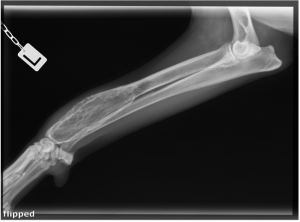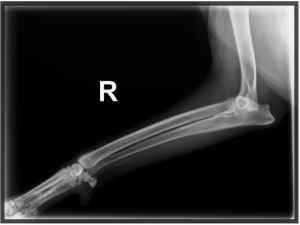July 24, 2024
Palliation for Osteosarcoma Bone Cancer
I met Roxy one snowy wintery day as she came running out to greet me, almost knocking me over with her exuberant personality. Roxy is 7.5 year old female Rottweiler. Her family was concern about the lameness on Roxy’s left front leg. At the time, she had been intermittently lame for about 2 months.
After her examination, she was started on some pain control medications while waiting for blood and urine results. Although Roxy passed her lab tests with flying colours; her x-rays told quite a different story.
X-Rays Showing Bone Cancer
Roxy’s x-rays showed bone destruction just above her wrist, on her left foreleg. These x-rays show her normal right front leg compared to the abnormal left front leg. Notice the ‘sun-burst’ appearance typically seen with destruction of bone.
Unfortunately, the most likely cause of this is osteosarcoma, ie. cancer tumour in the bone. A biopsy of the bone is required to confirm the diagnosis. Typical treatment would be amputation of the limb and chemotherapy. Unfortunately, even with this standard treatment, the survival rate is only 8-12 months.
Roxy’s family decided not to put her through this. So, we discussed palliative care for Roxy.
Pain Management Plan
The goal of palliative care is to achieve the best quality of life during life-limiting illness. The cornerstone of palliation lies in pain management. Osteosarcoma happens to be one of the most painful cancers, necessitating a well-rounded analgesic plan. As this cancer progress, there is a risk of pathological fractures at the site of the diseased bone.
Roxy was started on a combination of prescription medications and nutraceuticals that act synergistically to help manage her pain. They included prescription & natural anti-inflammatories, medication for wind-up and neuropathic pain. The medications are selected to produce a combined effect which is greater than the sum of their separate effects. In addition, Roxy received intravenous infusions of a medication to reduce the risks of pathological fractures.
2 weeks after starting her care, Roxy’s lameness has improved and currently undetectable. Even though the cancer has grown to a noticeable firm lump on her leg, Roxy is not showing any signs of discomfort. She remains the rambunctious dog who still jumps up to my face for kisses whenever I visit. Roxy’s zest for life is a reminder to take each day as it is and to enjoy everyday to its fullest!




